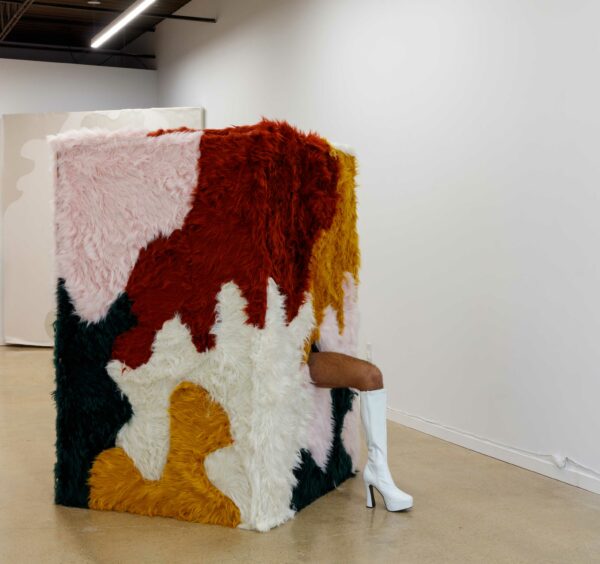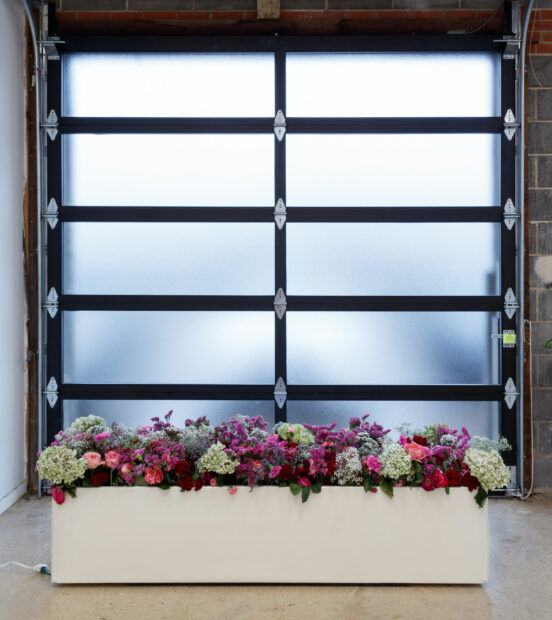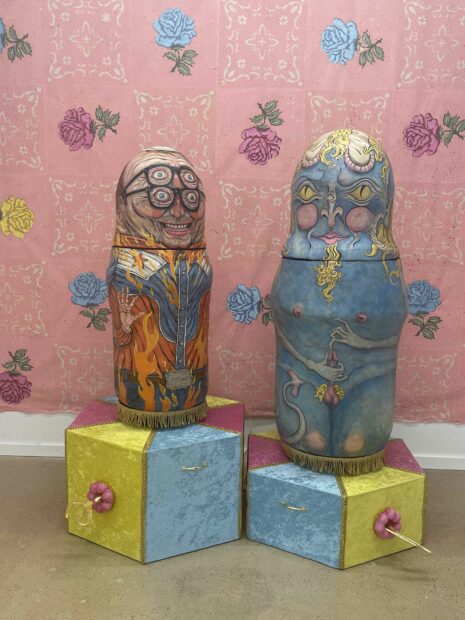Featuring the work of artist duo Chuck & George (C&G) and Colton James White, Three Dollar Bill utilizes camp and subversive humor to explore themes of high and low culture and queer identity, as well as the deconstruction of cultural norms. I’ve seen many Chuck & George exhibits throughout the years, and in them always feel like I’ve walked into a carnival side show, rich with spectacle and desire. By pairing their work with that of White, a performance artist, the exhibition’s objects take on additional themes of voyeurism and exploring what is unseen or hidden.
White’s work includes a large-scale box covered in faux fur in the middle of the gallery, and in the back corner, a large latex-covered wall. Both sculptures have circular openings that reference peepholes or glory holes. Inside the fur box is a stool, and inside the latex structure, a crutch. Unfortunately, I missed the opening reception where White performed within his sculptural works, extending body parts as an invitation for audience interaction. Putting one’s body on display for the audience is a courageous gesture, one that forces viewers into the role of voyeur. The artist’s body activates the space within and around the works, while in their absence, the sculptures function as empty vessels that reference fetish and unfulfilled desire.
White’s most unsettling work is a coffin-shaped sculpture in the gallery window. Filled with bunches of flowers in varying states of decay, the head of the coffin contains a video monitor displaying the artist’s face in full glam makeup. Like a funerary wake, viewers gaze down on the coffin, paying their respects. The body is either hidden or missing, yet we are treated to a digital performance of the artist staring at us via monitor, looping in perpetuity. I can’t help but make connections between White’s work and the newest season of American Horror Story, set in the 1980s and featuring New York City’s gay scene. Like other seasons, the show features a serial killer, but the real horror story is the devastating tragedy of so many lives lost to AIDS. I was in NYC as an undergrad at Pratt Institute during this time period, and the show brought back many memories of friends, some of whom are now dead due to the AIDS epidemic. White’s work is a reminder that the struggle for LGBTQIA+ rights is ongoing, and visibility is crucial.
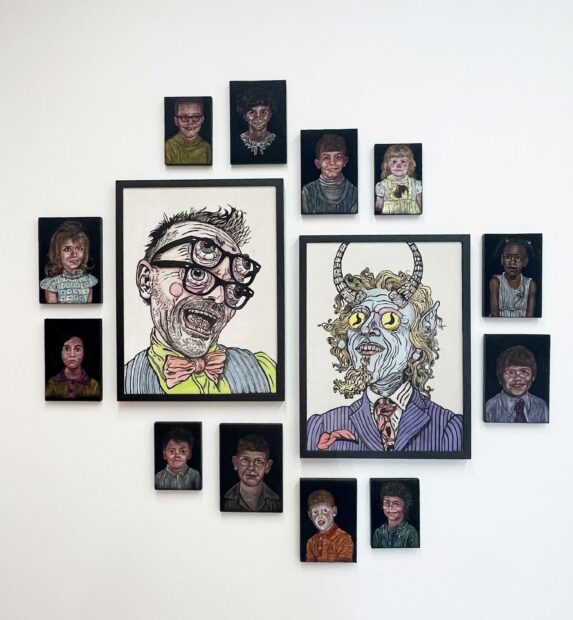
Chuck & George, “Yet Another Chuck & George Seasonal Portrait,” 2022, and “Portraits of Artist Friends as Children.” Photo by Colette Copeland.
Chuck & George’s work includes velvet paintings, a velvetorium, and Russian nesting dolls that don’t quite nest. C&G’s use of materials is loaded with content. Velvet is a tactile surface that invites viewers to touch, and is associated with indulgence and luxury. However, velvet paintings themselves are often associated with 1960’s and ‘70s kitsch. I find it interesting that black velvet paintings originated in Kashmir, where Russian orthodox priests painted religious icons on the material.
Twenty rainbow velvet canvases printed with the text “God Hates C&G” cover one gallery wall; the artists would have created more, but there was a shortage of rainbow velvet. The work is a bold statement about how the church has discriminated against gays, especially in the bible belt. As with much of C&G’s work, the meaning shifts with the choice of material and repetition. So rather than a damning phrase, it becomes a mantra of power. The rainbow velvet symbolizes pride, supporting LGBTQIA+ rights.
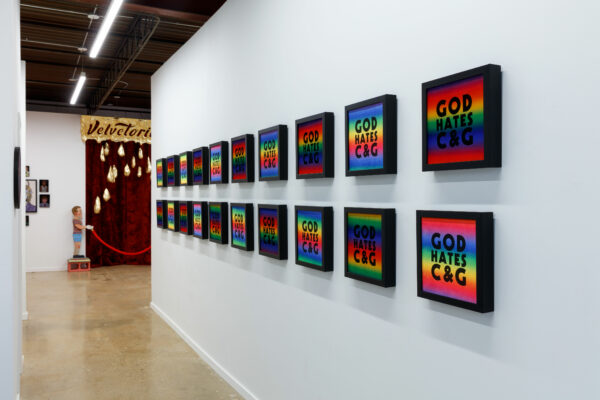
Chuck & George, “The Essential Chuck & George Protest Sign Installation,” 2022, print on velvet. Photo by Kevin Todora.
The Velvetorium is a multimedia installation which reminds me of a façade of a New York City sex/dance club from the 1980s, like the Tunnel, Pyramid, and Limelight, which come to mind. A gold sign hanging on the facade riffs off the Velveeta cheese logo, and big slabs of gold blobs hang from the sign. They look like slabs of meat to me, but the artists say they are cheese (the meat of vegetarians). A maroon velvet curtain and red rope prevent the viewer from entering. Reclaimed wooden Santas, reconfigured as C&G personas, serve as sentries. We want to see behind the curtain, but the artists’ work itself thwarts our desire.
My favorite works in the show are the almost human size Russian nesting dolls painted with the artists’ faces. If John Waters did a version of the Nutcracker, these nesting dolls would be the leading characters. Like the collectible music boxes with spinning ballerinas, the dolls rotate and appear to mock the viewer with each turn. In the background, the wall is painted with a fleur de lis pattern and flocked with velvet. The “winding key” is inserted into the dolls’ butt holes, which are made from ping pong balls. This piece makes me smile. I spent 3 years working as an usher for the New York State Theater and watched hundreds of Nutcracker performances. Just a few notes of Tchaikovsky’s score makes me break out into hives. These dolls provide a good antidote to those memories. The nesting dolls, as many of C&G works, are made from paper mâché, though at first glance they appear to be cast or carved out of high-end materials. Their smoothly sanded and intricately painted surfaces defy the medium. Like the carnival, we are seduced by the surface and want to see inside, but the magic is in preserving the illusion.
The exhibit title references the phrase, “queer as a three-dollar bill.” Historically, the term meant odd or strange, as well as inauthentic or fake, and then later became a slang term for homosexual. When researching the origin of the phrase, I found that there was a counterfeit $3 banknote issued in 1824 in Jefferson County, New York. Its literary origin comes from an Illinois campus newspaper circa 1945, where the article included the phrase describing a local ex-sailor and fireman named Filthy Willy. The phrase also is the name of Chicago’s first queercore band, and the name of Limp Bizkit’s debut album. By using this phrase as the exhibition title, curator Krista Chalkley, in conjunction with the artists, commits an act of reclaiming power, shifting the context from derogatory to celebratory.
Three Dollar Bill, featuring Chuck & George and Colton James White, is on view at Cluley Projects in Dallas, Texas through December 23, 2022. There will be a closing performance on Saturday, December 17th from 3:30 – 5:00 pm.


